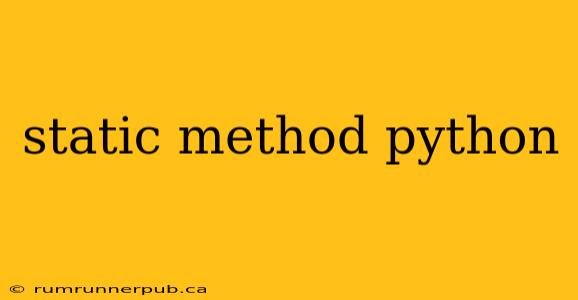Python, a versatile and widely-used programming language, offers various methods to structure your code effectively. Among these, static methods often cause confusion. This article clarifies their purpose, demonstrates their usage, and explores when they're most beneficial, drawing insights from Stack Overflow discussions to provide practical examples.
What is a Static Method?
A static method is a method that's bound to the class and not the instance of the class. Unlike instance methods (which have access to self), or class methods (which have access to cls), static methods don't implicitly receive any arguments related to the class itself. They behave like regular functions, but are logically grouped within a class for better organization.
Why Use Static Methods?
The primary reason to use a static method is for better code organization and readability. If you have utility functions closely related to the functionality of a class but don't need access to class state or instance data, making them static methods improves the overall structure. This is often referred to as the principle of least privilege; functions should only have access to the data they absolutely require.
Example: A Stack Overflow Inspired Illustration
A frequent question on Stack Overflow revolves around the best way to encapsulate helper functions within a class. Consider this scenario, inspired by a common pattern:
class MathUtils:
@staticmethod
def is_even(number):
"""Checks if a number is even."""
return number % 2 == 0
@staticmethod
def is_odd(number):
"""Checks if a number is odd."""
return not MathUtils.is_even(number) # demonstrates using another static method
def __init__(self):
pass # not using instance variables for this example
print(MathUtils.is_even(4)) # Output: True
print(MathUtils.is_odd(7)) # Output: True
In this example, is_even and is_odd are perfectly suited as static methods. They don't need access to any class or instance variables; they simply perform a calculation based on the input. Grouping them within the MathUtils class enhances readability and shows a clear relationship between these functions and mathematical operations. This mirrors the advice often given on Stack Overflow threads about organizing utility functions. This approach avoids polluting the global namespace with unrelated helper functions.
Differentiating Static Methods from Instance and Class Methods:
It's crucial to understand the distinctions between static methods and other types of methods in Python:
- Instance Methods: These methods receive
selfas the first argument, giving them access to the instance's attributes and methods. - Class Methods: These methods receive
clsas the first argument, allowing them access to the class itself (e.g., to create instances or access class-level variables). - Static Methods: These methods receive no implicit arguments related to the class or instance. They function independently.
When to Avoid Static Methods:
While static methods offer benefits, they are not always appropriate. If your function requires access to the class or instance state, you should use an instance or class method, respectively. Forcing the use of a static method in such scenarios would make your code less efficient and more difficult to understand.
Conclusion:
Static methods in Python are a powerful tool for organizing code, particularly for utility functions related to a class but not requiring access to class or instance data. By understanding their purpose and limitations, as well as learning from best practices highlighted in Stack Overflow discussions, you can write cleaner, more maintainable, and more efficient Python code. Remember the key: use static methods when a function is logically connected to a class but needs no access to the class's state.
